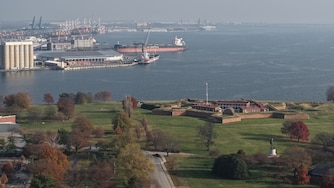In some neighborhoods, midsummer is marked by delicate white flower petals floating in the wind, drifting off tree branches and falling in the cracks of the sidewalks. In other neighborhoods, that’s a rarity.
Nationally and in Baltimore, low-income areas have disproportionately less leafy canopy than wealthier ones. And as the city marks some of the hottest days of the year, those neighborhoods will feel their absence. A study showed that more tree coverage can help keep city neighborhoods between 9 and 12 degrees cooler, said Ryan Alston, the Baltimore Tree Trust’s communications director.
Increasing tree equity, which means planting trees in areas that don’t have as many as others, is the main goal for the Baltimore Tree Trust, a nonprofit organization that planted 1,775 trees in its most recent planting season that ended in June.
“A lot of times we’re seeing a 10- to 12-degree difference on the same day at the exact same time in neighborhoods that don’t have high tree equities,” Alston said.
American Forests, a nonprofit organization that created the U.S. Forest Service, released a database in 2021 that measures tree equity scores in 150,000 neighborhoods and 486 urban areas across the country, including Baltimore, and found that areas like Old Town, Pigtown, Broadway East and Franklin Square had up to 60% less tree coverage than wealthier areas like Roland Park, Federal Hill and Canton.
The database reveals that a section of Pigtown with a low tree equity score can experience surface temperatures of 92 degrees, according to data measured by the U.S. Geographical Survey. Meanwhile, an area of Federal Hill with a high tree equity score can have a surface temperature of 86 degrees, even though the neighborhoods are under 2 miles apart.
According to a 2019 report by the University of Maryland’s Howard Center for Investigative Journalism, the city’s forestry division estimates that the current citywide tree canopy, which is a measurement of a tree leaves and branches that shelter the ground, is around 28%, which is shy of the city’s goal to increase the canopy to 40% coverage by 2037. The report also found that the city’s urban landscape, which contains many brick rowhouses, concrete sidewalks and asphalt streets, traps and radiates heat.
“We’re looking at those minority, disenfranchised areas that have been unfortunately affected by redlining and years of disinvestment,” Alston said, and added that her group focuses on neighborhoods in West and East Baltimore. “We want to reverse the effects that redlining has had on these communities by creating greener spaces, healthier neighborhoods, and just really bringing all of the benefits that trees can have to these residents.”
One of those areas, a section of North Milton Avenue in Broadway East, got new trees from the Tree Trust in June. Keith Morris, a Broadway East resident who was sitting on a bench with his friend near a newly planted tree, said he remembered when the group was there planting and said that the trees “bring class to the neighborhood.”
“I’m happy there’s more trees and a lot more shade,” he said. “The more trees, the more life, fresh air and fresh smells.”
Trees also absorb pollutants from air and water and reduce flood risks. Socially, they improve people’s moods and quality of life.
Baltimore Tree Trust, with its small team of about 30 employees, has been planting trees in low-income neighborhoods since 2008. This year, the group is anticipating landmark grants and funding from the U.S. Forest Service to inch toward their goal to plant 10,000 trees per year and expand their team to 90 members.
The Tree Trust also engages residents through door-to-door canvassing, flyers and having a presence at festivals to address misconceptions residents might have about trees.
“A lot of the interactions that we’re having are misconceptions of roots coming into water pipes or lifting up sidewalks,” Alston said. “Residents are concerned about the kind of maintenance a tree planted outside of their property will have.”
According to a release from Baltimore Gas and Electric Co., when planted properly, a single tree can save a homeowner up to 20% on energy costs through summer shading and by slowing cold winds in the winter.
The Tree Trust sources many of its trees through TreeBaltimore, a mayoral initiative led by Baltimore City Recreation and Parks, which has provided 5,300 subsidized trees to about 30 to 40 different groups in the last year. Of the trees, the initiative finds that native, understory trees have been more difficult to source, according to Kevin Nash, the public information officer of Baltimore Recreation and Parks.
“Large trees take many years to grow and we are currently in a lag period as nurseries expand their growing capacity,” he said. “Each season has its own challenges, but we look forward to a successful planting season effort this fall.”

Baltimore Tree Trust has a team that evaluates each location to select tree species that would thrive based on the environment of the tree well and how close it is to buildings or electrical wires. Alston said the group usually plants Maryland native species such as white oaks and flowering dogwoods, but climate change also has been favoring southern species of trees such as red bud, sycamore and cherry trees. She said they’ve planted the most trees in central West Baltimore and log each tree’s growth and progress in a geographic information system.
The summer and winter months are spent on maintenance and removing concrete sidewalks to expand and make room for new tree wells, which Alston said also helps reduce flood risks by acting “as a barrier for some of the stormwater runoff.”
This concrete cutting season will find the group in Waverly, Greenmount and Charles North. For the fall planting season, the Tree Trust will plant in neighborhoods including Hillen, Ramblewood, Harlem Park, Franklin Square and Penrose.





Comments
Welcome to The Banner's subscriber-only commenting community. Please review our community guidelines.